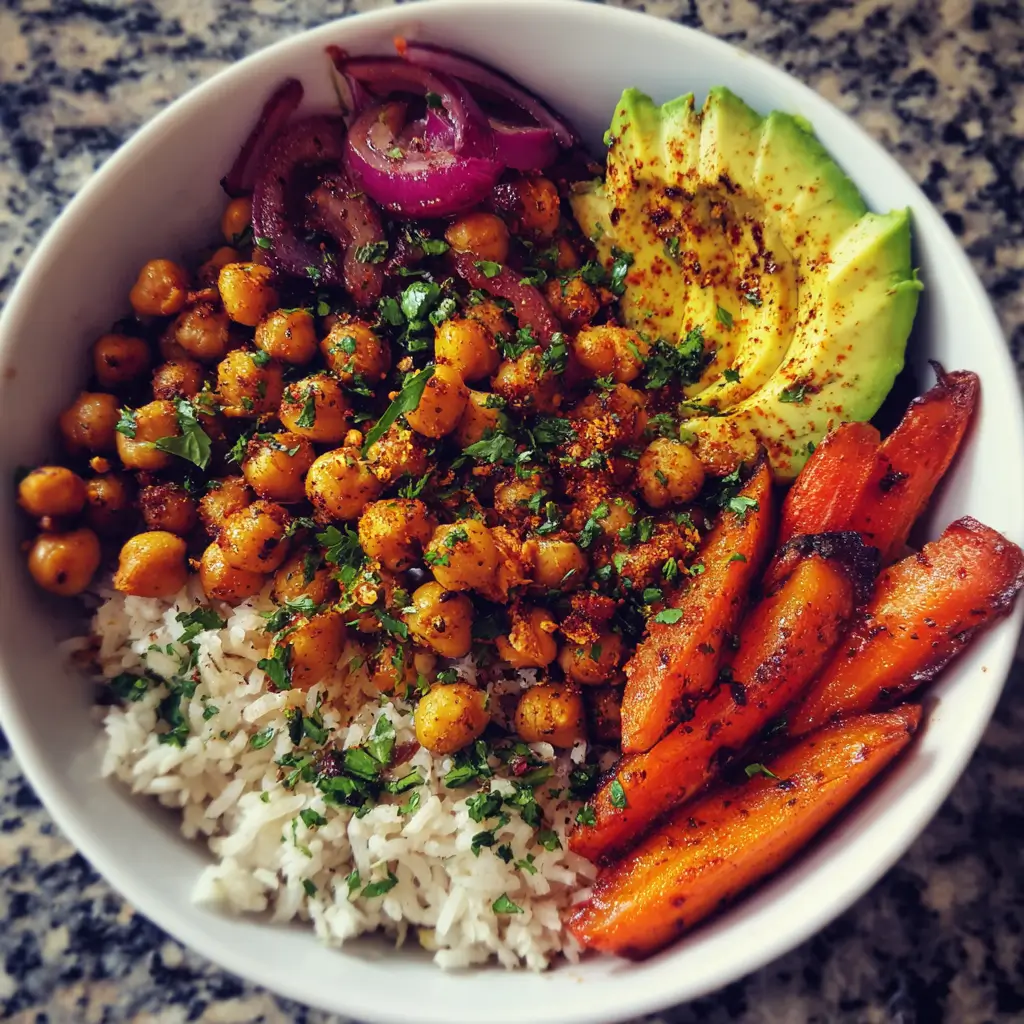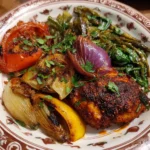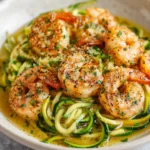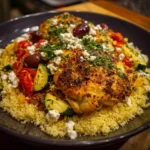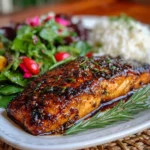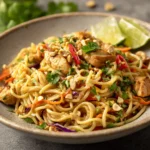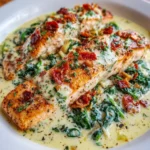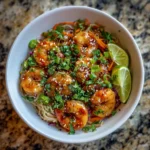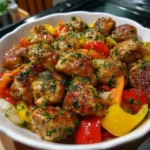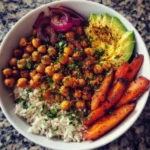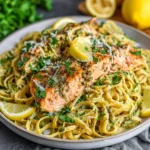Introduction
Welcome to a vibrant, nourishing, and deeply flavorful culinary journey with Moroccan Spiced Chickpea Bowls—a dish that beautifully marries the aromatic complexity of North African cuisine with the wholesome goodness of plant-based ingredients. This recipe is not only a feast for the palate but also a celebration of color, texture, and nutrition. Whether you’re a seasoned foodie or someone exploring meatless meals, these spiced chickpea bowls offer an accessible gateway into the rich tapestry of Moroccan flavors. Rooted in tradition yet effortlessly adaptable to modern dietary preferences, this bowl is perfect for weeknight dinners, meal prepping, or impressing guests at a weekend brunch. Packed with protein, fiber, and warming spices, it’s comfort food reimagined for the health-conscious and flavor-driven alike.
The History
Moroccan cuisine is a mosaic of cultural influences—Berber, Arab, Andalusian, and Mediterranean—all layered over centuries of trade, migration, and imperial exchange. The use of legumes like chickpeas has been central to Moroccan cooking since ancient times, thanks to their availability, affordability, and nutritional value. In regions such as Fez, Marrakech, and Tangier, chickpeas are staples in soups, stews, and salads, often enhanced with fragrant spice blends unique to the Maghreb region. One of the most iconic spice mixtures, ras el hanout, meaning “top of the shop,” refers to a premium blend crafted by spice merchants from up to 30 different spices, symbolizing the best their store has to offer. While traditional Moroccan dishes like tagines and couscous dominate international perception, everyday meals frequently feature humble yet flavorful preparations such as spiced chickpeas served with bread or grains. Our Moroccan Spiced Chickpea Bowl draws inspiration from street food culture and home-cooked meals across Morocco, where simplicity meets boldness on every plate. Over time, this type of preparation has gained global popularity, especially within vegetarian, vegan, and gluten-free communities seeking satisfying, culturally authentic meals.
Ingredients Breakdown
The beauty of Moroccan Spiced Chickpea Bowls lies in the harmony between simple base ingredients and complex, layered seasonings. Let’s explore each component:
- Chickpeas (Garbanzo Beans): The star ingredient, rich in plant-based protein, dietary fiber, iron, and folate. Canned chickpeas offer convenience, while dried ones provide a slightly creamier texture when cooked from scratch.
- Olive Oil: Used for sautéing, it adds heart-healthy monounsaturated fats and helps carry fat-soluble vitamins and flavors throughout the dish.
- Onion & Garlic: Aromatics that build the flavor foundation. Red onion can be used raw for garnish; yellow or white onions work well for cooking.
- Fresh Ginger: Adds a bright, zesty warmth that complements the earthy spices.
- Tomatoes: Fresh diced tomatoes add acidity and juiciness, balancing the richness of the spices. Alternatively, crushed canned tomatoes can deepen the sauce.
- Spices: The soul of the dish. Key players include cumin, coriander, paprika (smoked or sweet), turmeric, cinnamon, and optionally cayenne for heat. Together, they create a warm, slightly sweet, and subtly smoky profile reminiscent of Moroccan markets.
- Lemon Juice: Brightens the entire bowl, cutting through the richness and enhancing other flavors.
- Harissa Paste (optional): A North African chili paste that introduces a fiery depth. Adjust according to your spice tolerance.
- Cooked Whole Grains: Typically couscous, quinoa, bulgur, or brown rice serve as the base, offering sustained energy and texture contrast.
- Fresh Herbs: Cilantro and parsley are essential for freshness and vibrancy. Mint may also be added for a cooling twist.
- Toppings: Sliced olives, preserved lemons, roasted vegetables, crumbled feta (or vegan alternative), toasted almonds, or sesame seeds elevate both flavor and presentation.
Each ingredient contributes not just taste but also functional benefits, making this bowl a holistic meal.
Step-by-Step Recipe
- Prepare Your Base Grain: Cook 1 cup of quinoa, couscous, or brown rice according to package instructions. For extra flavor, cook in vegetable broth instead of water. Fluff with a fork once done and set aside.
- Sauté the Aromatics: Heat 2 tablespoons of olive oil in a large skillet over medium heat. Add 1 finely chopped yellow onion and cook until translucent (about 5 minutes). Stir in 3 minced garlic cloves and 1 tablespoon grated fresh ginger; sauté for another minute until fragrant.
- Bloom the Spices: Add 1 teaspoon ground cumin, 1 teaspoon ground coriander, 1 teaspoon smoked paprika, ½ teaspoon ground cinnamon, ½ teaspoon turmeric, and a pinch of cayenne (optional). Stir constantly for 30–60 seconds to toast the spices and release their essential oils—this step is crucial for maximum flavor development.
- Add Tomatoes and Chickpeas: Stir in 1 cup of diced fresh tomatoes (or ¾ cup crushed canned tomatoes) and two 15-ounce cans of rinsed and drained chickpeas. Mix well to coat the chickpeas in the spiced tomato mixture.
- Simmer the Mixture: Reduce heat to low, cover, and let the chickpeas simmer for 15–20 minutes, stirring occasionally. This allows the flavors to meld and the chickpeas to absorb the spices. If the mixture becomes too dry, add a splash of water or broth.
- Finish with Freshness: Remove from heat. Stir in the juice of half a lemon and ¼ cup chopped fresh cilantro. Taste and adjust seasoning with salt, pepper, or more lemon juice as needed.
- Assemble the Bowls: Divide the cooked grain among serving bowls. Top generously with the spiced chickpeas. Garnish with additional fresh herbs, sliced red onion, Kalamata olives, crumbled feta, a drizzle of harissa, and a sprinkle of toasted slivered almonds or pumpkin seeds.
- Serve Warm: Serve immediately while warm, perhaps with a wedge of lemon on the side for extra brightness.
Tips
- Toast Spices Carefully: Never skip blooming your spices in oil—it intensifies their aroma and integrates them into the dish. But watch closely to avoid burning, which can make the dish bitter.
- Rinse Canned Chickpeas Well: Rinsing removes excess sodium and the starchy liquid that can cause digestive discomfort.
- Use Preserved Lemons (if available): These are a North African staple—tangy, salty, and intensely citrusy. Finely chop the rind and use sparingly as a garnish for an authentic touch.
- Batch Cooking Friendly: This recipe reheats beautifully. Store components separately in airtight containers for up to 5 days in the fridge or freeze chickpea mixture for up to 3 months.
- Texture Matters: For a chunkier stew, lightly mash some chickpeas with the back of a spoon during cooking. For a saucier consistency, add ¼–½ cup of vegetable broth before simmering.
- Balance Acidity: Always finish with lemon juice or vinegar to lift the flavors. Taste before serving and adjust accordingly.
- Prep Ahead: Chop all vegetables, measure spices, and cook grains in advance to streamline assembly on busy days.
- Oil-Free Option: Sauté aromatics in water or broth to keep the dish completely oil-free for a whole-food, plant-based diet.
Variations and Customizations
This recipe is incredibly versatile—here are creative ways to tailor it to your taste or dietary needs:
- Vegan Version: Omit feta or substitute with dairy-free cheese or tahini drizzle. Ensure harissa is vegan (some contain honey).
- Gluten-Free: Use certified gluten-free grains like quinoa, millet, or buckwheat. Avoid couscous unless labeled GF (it’s typically wheat-based).
- Protein Boost: Add grilled tofu, tempeh, falafel, or a poached egg for extra protein.
- Roasted Vegetable Twist: Include roasted sweet potatoes, carrots, zucchini, or eggplant for added sweetness and depth.
- Grain Alternatives: Try farro, freekeh, or cauliflower rice for lower-carb or ancient grain options.
- Spice Level Control: Omit cayenne and reduce harissa for mild flavor, or add diced fresh chilies for intense heat.
- Mediterranean Fusion: Incorporate artichoke hearts, sun-dried tomatoes, capers, and hummus swirl for a coastal twist.
- Breakfast Bowl: Serve over wilted spinach with a fried egg and za’atar seasoning for a savory morning meal.
- Meal Prep Jars: Layer ingredients in mason jars—grains at the bottom, then chickpeas, followed by sturdy veggies, and herbs on top. Shake and reheat when ready to eat.
- Kid-Friendly Version: Reduce spices, omit chili, and serve with pita bread for dipping. Call it “Moroccan Hummus Bowls” for fun appeal.
Health Considerations and Nutritional Value
Moroccan Spiced Chickpea Bowls are a powerhouse of balanced nutrition:
- High in Fiber: Chickpeas and whole grains promote digestive health, stabilize blood sugar, and support satiety—ideal for weight management and gut health.
- Plant-Based Protein: With approximately 15–20 grams of protein per serving (depending on grain and toppings), this bowl supports muscle repair and long-lasting energy without animal products.
- Rich in Micronutrients: Iron from chickpeas (enhanced by vitamin C from tomatoes and lemon), folate for cellular function, magnesium for nerve health, and antioxidants from colorful vegetables and spices.
- Anti-Inflammatory Properties: Turmeric contains curcumin, known for its anti-inflammatory effects. Cinnamon helps regulate blood sugar, while garlic supports immune function.
- Heart-Healthy Fats: Olive oil provides monounsaturated fats linked to reduced cardiovascular risk. Nuts and seeds add omega-3s.
- Low Glycemic Index: Especially when using whole grains like quinoa or bulgur, this meal prevents spikes in blood glucose, beneficial for diabetics.
- Digestive Support: Fermented options like preserved lemons or probiotic-rich toppings (e.g., coconut yogurt) can enhance microbiome diversity.
- Considerations: Those with kidney issues should monitor potassium intake (chickpeas are high in potassium). Individuals sensitive to FODMAPs may need to limit chickpeas or opt for canned and thoroughly rinsed versions to reduce oligosaccharides. Sodium content can be managed by using low-sodium canned chickpeas and limiting added salt.
Overall, this bowl aligns with principles of the Mediterranean and DASH diets—both celebrated for longevity and disease prevention.
Ingredients
- 2 tablespoons olive oil (or water/broth for oil-free)
- 1 large yellow onion, finely chopped
- 3 garlic cloves, minced
- 1 tablespoon fresh ginger, grated
- 1 cup fresh tomatoes, diced (or ¾ cup crushed canned tomatoes)
- 2 (15 oz) cans chickpeas, rinsed and drained
- 1 tsp ground cumin
- 1 tsp ground coriander
- 1 tsp smoked paprika
- ½ tsp ground cinnamon
- ½ tsp ground turmeric
- Pinch of cayenne pepper (optional)
- 1 tsp harissa paste (adjust to taste)
- Juice of ½ lemon (plus more to taste)
- Salt and freshly ground black pepper, to taste
- ¼ cup fresh cilantro, chopped (plus more for garnish)
- 2 cups cooked whole grain (quinoa, couscous, brown rice, etc.)
- Garnishes (choose your favorites):
- Sliced red onion
- Kalamata olives
- Crumbled feta or vegan cheese
- Toasted almonds, pine nuts, or pumpkin seeds
- Preserved lemon (finely chopped)
- Extra harissa or tahini for drizzling
- Fresh parsley or mint
Directions
- In a medium saucepan, prepare your chosen grain according to package directions. For enhanced flavor, substitute water with vegetable broth. Once cooked, fluff with a fork, cover, and set aside.
- Heat olive oil in a large nonstick skillet over medium heat. Add chopped onion and sauté for 4–5 minutes until soft and translucent.
- Stir in minced garlic and grated ginger; cook for 1 minute until fragrant, taking care not to burn.
- Add cumin, coriander, smoked paprika, cinnamon, turmeric, and cayenne (if using). Stir continuously for 30–60 seconds to toast the spices and develop deep flavor.
- Mix in diced tomatoes and harissa paste. Cook for 2 minutes, allowing the mixture to begin thickening slightly.
- Add the rinsed chickpeas to the skillet. Stir well to coat them evenly with the spiced tomato base.
- Reduce heat to low. Cover and simmer for 15–20 minutes, stirring occasionally. If the mixture dries out, add 2–4 tablespoons of water or broth to maintain moisture.
- Remove from heat. Stir in lemon juice, chopped cilantro, salt, and pepper. Taste and adjust seasoning—add more lemon for brightness, harissa for heat, or salt for balance.
- To assemble, divide the cooked grain among four bowls. Top each with a generous portion of spiced chickpeas.
- Garnish creatively: add sliced red onion, olives, feta, nuts, herbs, and a final drizzle of olive oil, harissa, or tahini.
- Serve immediately while warm, with extra lemon wedges on the side.
FAQ
Can I make this ahead of time?
Yes! The spiced chickpeas reheat very well and actually taste better the next day as flavors deepen. Store in the refrigerator for up to 5 days or freeze for 3 months. Reheat on the stove or microwave, adding a splash of water if needed.
Are canned chickpeas okay to use?
Absolutely. Canned chickpeas are convenient and perfectly suitable. Just rinse them thoroughly to remove excess sodium and improve digestibility.
What can I use instead of harissa?
If harissa isn’t available, substitute with sriracha, chili garlic paste, or a pinch of red pepper flakes. For authenticity, try making homemade harissa with roasted red peppers, chili, garlic, and spices.
Is this dish spicy?
It can be! The heat level depends on harissa and cayenne. Start with less and adjust to your preference. The spices are more warm and aromatic than fiery unless you boost the chili.
Can I bake the chickpeas for crunch?
Yes! For a crispy topping, toss drained chickpeas with spices and roast at 400°F (200°C) for 20–30 minutes until crunchy. Use them as a salad topper instead of simmering.
How do I make this gluten-free?
Simply choose a gluten-free grain like quinoa, millet, or certified gluten-free rice. Double-check labels on harissa and broth to ensure no hidden gluten.
Can I use dried chickpeas?
Yes, but they require soaking overnight and boiling for 1–2 hours until tender. Using dried chickpeas gives creamier texture and allows better spice absorption, though it takes more time.
What’s the best grain to pair with this?
Quinoa offers complete protein and a light texture. Couscous is traditional and fluffy. Brown rice adds chewiness and nuttiness. All work wonderfully—choose based on preference or pantry availability.
Can I turn this into a soup or stew?
Absolutely. Add 1–2 cups of vegetable broth to the chickpea mixture during simmering for a hearty, soup-like consistency. Serve with crusty bread for dipping.
Is this kid-friendly?
With minor adjustments—reducing spices, skipping chili, and adding mild toppings like avocado or corn—most children enjoy the savory, slightly sweet flavor profile. Serve with pita for fun finger-food style eating.
Summary
Moroccan Spiced Chickpea Bowls blend aromatic spices, protein-rich legumes, and wholesome grains into a vibrant, nutrient-dense meal that celebrates North African culinary heritage. Easy to customize, naturally plant-based, and bursting with flavor, this bowl is as nourishing as it is delicious.
